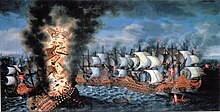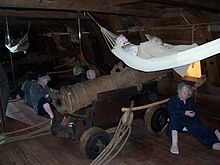Kronan (ship)
|
|
|
|---|---|

|
|
| Technical specifications | |
| Ship type: | Sailing ship |
| Class: | |
| Purpose: | Warship |
| Volume: | |
| Displacement: | 2200 t |
| Length (o.a.): | approx. 54 m |
| Width (above): | 12.91 m |
| Draft: | 6.23 m |
| Speed: | |
| Crew: | 500 |
| Soldiers: | 300 |
| Keel laying: | October 27th Jul. / November 6th 1665 greg. |
| Completion: | 1672 |
| Fate: | sunk on June 1st jul. / June 11, 1676 greg. |
The Kronan (Eng. "The Crown") was a Swedish warship that was built between 1665 and 1672 under King Charles XI. was built. She was designed for use in the Swedish Navy during the Skåne War and, along with the Vasa, was one of the largest sailing ships of the 17th century.
construction
Construction of the Kronan began on October 27th July. / November 6th 1665 greg. in the Royal Navy Yard on Skeppsholmen Island in Stockholm . Due to a lack of funds, the construction was delayed until 1672. The ship was about 54 meters long, 12.91 meters wide and had a draft of 6.23 meters. The displacement was over 2000 tons. The crew consisted of 500 sailors and about 300 soldiers. The Kronan held a total of 126 cannons, which were spread over three decks. This was twice as many cannons as were intended for the Vasa .
Cannons
- 12 × 36-pound cannons
- 16 × 30-pound cannons
- 40 × 24-pound cannons
- 2 × 18-pound cannons
- 36 × 12-pound cannons
- 20 × 6-pound cannons
Downfall

From 1675 Sweden and Denmark fought for the former Danish possessions in southern Sweden, which had been ceded to Sweden by Denmark in the Peace of Roskilde in 1658 . The Kronan was supposed to join the Swedish fleet off the island of Öland in June 1676 in order to fight a battle for naval supremacy on the Baltic Sea against a united Dutch-Danish fleet. In the lunchtime of June 1st jul. / June 11, 1676 greg. During the sea battle at Öland , the ship, which was under full sail, was listed when it was hit by a gust of wind during a risky turning maneuver. The cannon anchorages on one side probably came loose and a serious explosion occurred around 1 p.m., which was probably caused by the fact that the shattered powder kegs inside the ship came into contact with burning fuses. Then the Kronan sank very quickly and took the Admiral General of the fleet and its captain, Baron Lorentz Creutz , as well as 839 men of the crew into the depths. Only about 40 to 50 men survived the accident. The sinking of the Kronan would go down as the greatest shipwreck in Sweden's history.
Lorentz Creutz, who had died, was identified as the culprit for the sinking, as he had ordered the risky turning maneuver that ultimately contributed to the capsizing, despite adverse easterly winds and the proximity to the coast.
Salvage
With the help of primitive diving bells, a total of 60 cannons could be recovered between 1680 and 1686. After that, the ship was forgotten for almost 300 years.
The wreck of the Kronan was rediscovered in 1980 by the Swedish marine archaeologist Anders Franzén . Franzén was also in charge of the recovery of the Vasa . Together with Bengt Grisell and Sten Ahlberg, he was able to locate the ship on August 8, 1980 off the east coast of Öland at a depth of about 30 meters. The divers found many oak planks and human bones scattered around the bottom of the Baltic Sea. The hull of the ship had broken in two, but a large part of the port side turned out to be intact and lies with the outer surface on the seabed to this day. Soon after the discovery of the wreck, the archaeological investigation and conservation of the found objects began.
treasure
In addition to the actual parts of the ship (cannons, remains of the crew and their belongings), over 250 gold coins were recovered between 1982 and 1983. This find represented the largest treasure ever found in Sweden. But in 1998 this treasure was surpassed by an even bigger one, when a silver coin treasure with 6,500 coins was discovered near the wreck. The money was evidently intended as pay for senior Kronan officers .
The Kronan today
All the remains of the Kronan that were found were collected and some of them can be seen today in the State Museum in the port of Kalmar . Part of the Kronan was also rebuilt in this harbor , so that one can immerse himself in life on board the sailing ship.
Another attraction is the construction of a dedicated museum for the Kronan , in which the preserved side of the ship is to be exhibited.
Web links
- Entry of the wreck site in the state monument database - entry in the "Fornsök" database of the Riksantikvarieämbetet (Swedish). Retrieved May 3, 2015
- The Kronan in the National Museum of Kalmar
- The Kronan on the Nordic Underwater Archeology website
Coordinates: 56 ° 26 ′ 24 ″ N , 16 ° 42 ′ 2 ″ E


